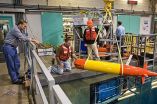(Press-News.org) Canadians who work night and rotating shifts are almost twice as likely to be injured on the job than those working regular day shifts, according to a study by researchers at the University of British Columbia.
The study, published in the current issue of the Scandinavian Journal of Work, Environment and Health, examined data on more than 30,000 Canadians collected as part of Statistics Canada's Survey of Labour and Income Dynamics and compared results between workers involved in different types of shift work from 1996-2006. It shows that while the overall rate of work injuries in Canada decreased during this time, the rate of injuries did not decline for night shift workers.
The study also found that the risk of work injury associated with shift work was more pronounced for women, especially if they work rotating shifts.
"The disruption of normal sleep patterns due to shift work can cause drowsiness or fatigue, which can lead to workplace injuries," says Imelda Wong, a PhD Candidate at UBC's School of Environmental Health and the study's lead author. "Our research shows that people working rotating and night shifts are more likely to experience an injury than those who work regular day hours."
The researchers suggest that because women are more likely to be responsible for childcare and household work, they may have more difficulties adjusting to shift work and maintaining regular sleep schedules.
The number of Canadians working non-standard hours has increased dramatically in recent decades. The number of women in rotating and night shift work increased by 95 per cent during the study period, primarily in the health care sector. For men, the increase was 50 per cent, mostly in manufacturing and trades.
In 2006, 307,000 work-related injury claims associated with shift work represented more than $50.5 million in costs to Canada's workers' compensation system.
"As more and more workers become involved in non-daytime shift work, we may see an increase in injuries, especially among women," says co-author Chris McLeod, a research associate at UBC's Centre for Health Services and Policy Research (CHSPR). "Regulatory agencies and employers need to consider policies and programs to help reduce the risk of injuries among shift workers."
INFORMATION:
The study was funded by the WorkSafeBC-CHSPR Research Partnership. WorkSafeBC is British Columbia's workers' compensation board. The third co-author of the study is Paul Demers, director of the Occupational Cancer Research Centre in Toronto and clinical faculty member at the UBC School of Population and Public Health.
The abstract for the study is available at http://www.sjweh.fi/show_abstract.php?abstract_id=3124
The UBC Centre for Health Services and Policy Research conducts independent, policy relevant research and graduate training, and is dedicated to fostering visionary research within a collaborative and innovative research environment. The Centre's work engages and informs health policy and issues that matter to Canadians.
The WorkSafeBC-CHSPR Research Partnership aims to address current and emerging issues of work-related health in British Columbia. The Partnership conducts research that provides a unique and comprehensive portrait of the health and well being of workers, and helps support evidence-informed decision-making in the area of occupational health.
Shift work linked to higher risk of work injury: UBC study
2010-11-03
ELSE PRESS RELEASES FROM THIS DATE:
Every person emits 2 tons of CO2 a year through eating
2010-11-03
Every person emits the equivalent of approximately two tonnes of carbon dioxide a year from the time food is produced to when the human body excretes it, representing more than 20% of total yearly emissions. That is what a study by the Universidad de Almería says, confirming for the first time that human excrements contribute to water pollution, primarily with nitrogen and phosphorus.
A team of researchers from the Universidad de Almería (UAL) has estimated the environmental impact of the Spanish diet and role that human excrements play in the life cycle of food. It is ...
Algae for biofuels: Moving from promise to reality, but how fast?
2010-11-03
A new report from the Energy Biosciences Institute (EBI) in Berkeley projects that development of cost-competitive algae biofuel production will require much more long-term research, development and demonstration. In the meantime, several non-fuel applications of algae could serve to advance the nascent industry.
"Even with relatively favorable and forward-looking process assumptions (from cultivation to harvesting to processing), algae oil production with microalgae cultures will be expensive and, at least in the near-to-mid-term, will require additional income streams ...
Exposure of humans to cosmetic UV filters is widespread
2010-11-03
Amsterdam, 2 November, 2010 - An investigation conducted in the context of the Swiss National Research Programme (NRP50), Endocrine Disrupters: Relevance to Humans, Animals and Ecosystems, demonstrates for the first time that internal exposure of humans to cosmetic UV filters is widespread.
In the course of the Summer and Fall 2004, 2005 and 2006 (3 cohorts), human milk was sampled by mothers who had given birth at the University Women's Hospital in Basel. The participants filled out a detailed questionnaire with general questions and, as special feature, in depth questions ...
New long-range undersea robot goes the distance
2010-11-03
Over the past decade, the undersea robots known as autonomous underwater vehicles (AUVs) have become increasingly important in oceanographic research. Today's AUVs fall into two groups: 1) propeller-driven vehicles that can travel fast and carry lots of instruments, but are limited to expeditions of only a few days; and 2) "gliders," which can stay at sea for weeks or even months at a time, but cannot travel very quickly. MBARI engineers recently demonstrated a new super-efficient AUV that combines the best of these two approaches. This new long-range AUV (LRAUV) can travel ...
Mayo Clinic Proceedings: November highlights
2010-11-03
The November issue of Mayo Clinic Proceedings includes three articles with leading research, highlighted below.
Khat Chewing Increases Risk of Stroke and Death in Patients With Acute Coronary Syndrome
ROCHESTER, Minn. -- Researchers found that people who chew khat and present with acute coronary syndrome had significantly higher rates of death, cardiogenic stroke, and stroke complications, despite having lower cardiovascular risk profiles.
"The leaves of khat, a leafy green shrub, are chewed habitually for euphoric and stimulating effects. The main ingredients, ...
First peer-reviewed study finds BPA levels in US foods 1,000 times less than limits
2010-11-03
Note to journalists: Please credit the journal or the American Chemical Society as publisher of this report.
WASHINGTON, Nov. 2, 2010 — For the first time in the United States, researchers are reporting in a peer-reviewed scientific journal today detection of Bisphenol A (BPA) in fresh and canned food as well as food wrapped in plastic packaging. The amounts in the limited sample, however, were almost 1,000 times lower than the "tolerable daily intake" levels set by the U.S. Environmental Protection Agency (EPA) and the European Food Safety Authority (EFSA). Their report ...
Mouse model confirms mutated protein's role in dementia
2010-11-03
A team of scientists from Japan and the University of California, San Diego School of Medicine have created a new mouse model that confirms that mutations of a protein called beta-synuclein promote neurodegeneration. The discovery creates a potential new target for developing treatments of diseases like Parkinson's and Alzheimer's.
The work is published in today's issue of Nature Communications. Lead author is Makoto Hashimoto of the Division of Chemistry and Metabolism, Tokyo Metropolitan Institute for Neuroscience, with colleagues including Eliezer Masliah, MD, professor ...
New research from Psychological Science
2010-11-03
A Spontaneous Self-Reference Effect in Memory: Why Some Birthdays Are Harder to Remember Than Others (http://pss.sagepub.com/content/21/10/1525.abstract)
Selin Kesebir and Shigehiro Oishi
People may have a better memory for birthdays that are closer to their own: Volunteers recalling their friends' birthdays tended to remember birthdays that were closer to their own than birthdays that were farther away from their own birthday. In a separate experiment, after reading brief biographies of people they did not know, volunteers correctly remembered the birthdays of the ...
Geriatrician advocates for improvements to primary care to meet the needs of older adults
2010-11-03
In an article published in November 3 edition of Journal of the American Medical Association (JAMA), Chad Boult, MD, MPH, MBA, professor of Health Policy and Management at the Johns Hopkins Bloomberg School of Public Health, calls for key improvements to primary care in order to improve the health of the nation's most costly patients—older adults with multiple chronic conditions. Boult and his co-author, G. Darryl Wieland, PhD, MPH, research director of Geriatrics Services at Palmetto Health Richland Hospital, Columbia, South Carolina, evaluated studies of new primary care ...
UMass Medical School study points to genetic link in apnea of prematurity
2010-11-03
WORCESTER, Mass. – A potentially life-threatening challenge characterized by pauses in breathing that can last for more than 20 seconds, apnea of prematurity (AOP) affects more than 50 percent of premature infants and is almost universal in the smallest of preemies. Caused in part by an underdeveloped central nervous system that can't adequately regulate breathing outside of the womb, especially during sleep, AOP is not yet fully understood by scientists and remains a grave concern among neonatologists and parents alike. New research published in the October issue of Pediatrics ...



